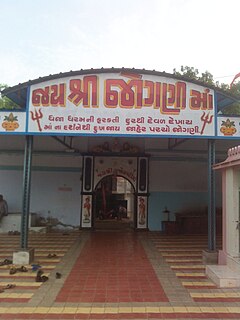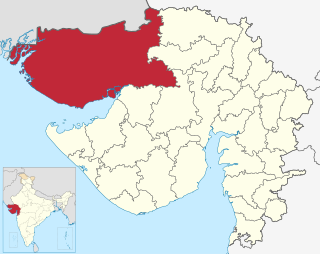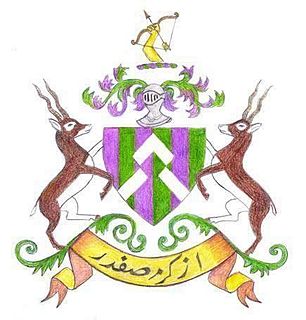Related Research Articles

Lakhpat is a sparsely populated town and sub-district in the Kachchh district in the Indian state of Gujarat located at the mouth of the Kori Creek. The town is enclosed by 7km-long, 18th-century fort walls.

Khavda is a village in Bhuj Taluka of Kutch district of Gujarat, India. It lies on the west side of Pachham Island in Greater Rann of Kutch.
Tuna Port is a port town in Anjar taluka of Kutch district of Gujarat, India.

Cutch, also spelled Kutch or Kachchh and also historically known as the Kingdom of Kutch, was a kingdom in the Kutch region from 1147 to 1819 and a princely state under British rule from 1819 to 1947. Its territories covered the present day Kutch region of Gujarat north of the Gulf of Kutch. Bordered by Sindh in the north, Cutch State was one of the few princely states with a coastline.

Gundiyali is a village near Mandvi of Kutch district of Gujarat, India.

Vira is a village in Anjar Taluka in Kutch district of Gujarat, India. Nearby temple of Jogninar is place of religious significance.
Maharajadhiraj Mirza Maharao Bharmalji II was the Rao of Cutch belonging to Rajput dynasty, who ascended the throne of Princely State of Cutch one month after the death of his father Rayadhan III.
Rao Prithvirajji, also known as Bhaiji Bava, was the Rao of Cutch belonging to Jadeja Rajput dynasty, who ascended the throne of Princely State of Cutch as a titular head in 1786 and ruled until 1801 when he died at the early age of twenty seven. He ruled as titular head under council of Bar Bhayat ni Jamat.
Bar Bhayat ni Jamat was a council of twelve members which managed Cutch State under titular kings Prithvirajji from 1786 to 1801 and under Rayadhan III from 1801 to 1813. The council was chiefly led by Fateh Muhammad during both period. The council is also known as Bar Bhayyat or Bar Bhaya.

Fateh Muhammad was a regent who administered Cutch State as a leader of Bar Bhayat ni Jamat under titular kings, Prithvirajji and Rayadhan III.
Rao Godji II, was the Rao of Cutch belonging to Jadeja Rajput dynasty, who ascended the throne of Princely State of Cutch in 1760 and ruled until 1778 when he died. During his rein, the state was invaded by Kalhoras and Talpuras of Sindh several times.

Rao Lakhpatji, also known as Lakhaji, was the Rao of Cutch belonging to Jadeja Rajput dynasty, who ruled Princely State of Cutch as a regent from 1741 to 1752. Later succeeded his father Deshalji I in 1752 and ruled until his death in 1760.
Rao Deshalji I was the Rao of Cutch belonging to Jadeja Rajput dynasty, who ruled Princely State of Cutch as a regent from 1718 1752. His son Lakhpatji confined him in 1741 and ruled as a regent until death of Deshalji in 1752.
Rao Pragmalji I was the Rao of Cutch belonging to Jadeja Rajput dynasty, who ruled Princely State of Cutch as from 1698 to 1715. He established current lineage of rulers of the state in 1698.
Captain James MacMurdo was the first political resident of British East India Company to Cutch State. He played important role in bringing Cutch under British suzerainty.

The history of Kutch, a region in the extreme west of the western Indian state of Gujarat, can be traced back to prehistorical times. There are several sites related to Indus valley civilization in region and is mentioned in Hindu mythology. In historical times, Kutch is mentioned in Greek writings during Alexander. It was ruled by Menander I of Greco-Bactrian Kingdom which was overthrown by Indo-Scythians followed by Maurya Empire and Sakas. in the first century, it was under Western Satraps followed by Gupta Empire. By fifth century, Maitraka of Valabhi took over from which its close association with ruling clans of Gujarat started. Chavdas ruled the eastern and central parts by seventh century but then came under Chaulukyas by tenth century. After fall of Chaulukya, Vaghelas ruled the state. Following conquest of Sindh by Muslim rulers, Rajput Samma started moving southwards to Kutch and ruled western regions initially. By tenth century, they controlled significant area of Kutch and by thirteenth century they controlled whole of Kutch and adopted a new dynastic identity, Jadeja.
The history of Palanpur starts with its relation to the historic city of Chandravati ruled by Paramara dynasty. The town was re-peopled and ruled by Chauhans around thirteenth century. At the start of the seventeenth century, the Palanpur State was taken over by Jhalori dynasty of Pashtun Lohani (Bihari-Pathan) tribe which was founded in 1373 and ruled from Jhalor. The dynasty came into historical prominence during the period of instability that followed the demise of Mughal Emperor Aurangzeb in the early 18th century. It was overrun soon afterwards by the Marathas; the Lohanis followed the trend of seeking recourse in the British East India Company against them and finally entered the subsidiary alliance system in 1817, along with all other neighbouring states, becoming a British protectorate governed by Palanpur Agency. After independence of India in 1947, Palanpur State was dissolved in 1949 and merged with India as a part of Bombay State. Subsequently, Palanpur became the capital of Banaskantha district of Gujarat.(Hebatpur)

Radhanpur is a town and a municipality in Patan district in the Indian state of Gujarat. Radhanpur belonged to the Vaghelas in early years and later it was held as a fief under the Gujarat Sultanate by Fateh Khan Baloch. During Mughal period, the descendants of Babi dynasty were appointed as the governor of Radhanpur and other villages of North Gujarat. After decline of Mughal, they became free and established themselves as independent rulers. In 1743, Babi descendant Jawan Mard Khan II took over viceroyalty of Ahmedabad and controlled several villages in North Gujarat. He was defeated by Maratha Gaekwads in 1753 at Ahmedabad and Gaekwads agreed to his demand of control of villages in North Gujarat headquartered at Radhanpur State. His descendants lost some of these villages to Gaekwads subsequently. In 1813, Sher Khan made a treaty with the Gaekwar and British and became British protectorate. His descendants ruled the state until independence of India in 1947.
Santalpur is a village in Santalpur Taluka of Patan district of Gujarat state, India.
Tervada is a village in Kankrej Taluka of Banaskantha district in Gujarat, India.
References
Notes
- ↑ Chisholm, Hugh, ed. (1911). . Encyclopædia Britannica . Vol. 7 (11th ed.). Cambridge University Press. p. 670.
- ↑ Gazetteer of the Bombay Presidency: Cutch, Palanpur, and Mahi Kantha 2015, p. 147.
- ↑ Gazetteer of the Bombay Presidency: Cutch, Palanpur, and Mahi Kantha 2015, pp. 147–148.
- 1 2 Gazetteer of the Bombay Presidency: Cutch, Palanpur, and Mahi Kantha 2015, p. 148.
- 1 2 Gazetteer of the Bombay Presidency: Cutch, Palanpur, and Mahi Kantha 2015, p. 149.
- ↑ Gazetteer of the Bombay Presidency: Cutch, Palanpur, and Mahi Kantha 2015, p. 151.
- ↑ Gazetteer of the Bombay Presidency: Cutch, Palanpur, and Mahi Kantha 2015, pp. 151–152.
- 1 2 Gazetteer of the Bombay Presidency: Cutch, Palanpur, and Mahi Kantha 2015, p. 152.
- ↑ Gazetteer of the Bombay Presidency: Cutch, Palanpur, and Mahi Kantha 2015, p. 155.
Bibliography
- Gazetteer of the Bombay Presidency: Cutch, Palanpur, and Mahi Kantha. Government Central Press. 1880. pp. 147–155.
 This article incorporates text from this source, which is in the public domain .
This article incorporates text from this source, which is in the public domain .